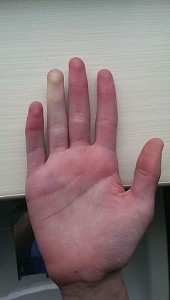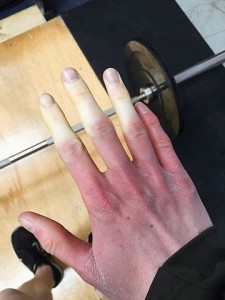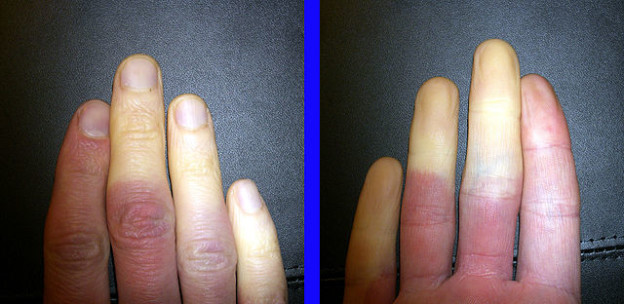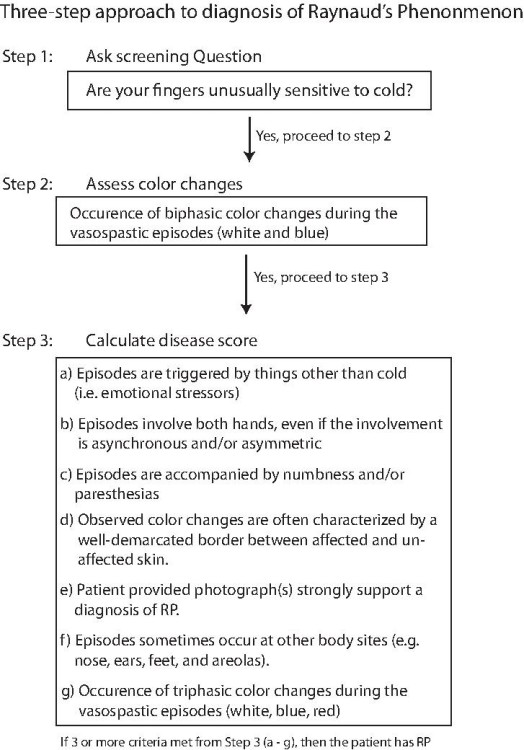Raynaud’s Disease — Causes, Symptoms and Treatment
Table of Contents
- Introduction
- Definition of Raynaud’s Disease
- Classification of Raynaud’s Disease
- Symptoms of Raynaud’s Disease
- Pathophysiology of Raynaud’s Disease
- Associations of Raynaud’s Disease
- Clinical Features of Raynaud’s Disease
- Diagnosis and Investigations of Raynaud’s Disease
- Treatment of Raynaud’s Disease
- Prognosis of Raynaud’s Disease
- Review Questions
- References
Image: “Back and front of a hand of a person suffering from Raynaud’s disease” by Vertebro. License: Public Domain
Introduction
Raynaud’s disease (also Raynaud, or Raynaud’s phenomenon) was first described in 1862 by Auguste Raynaud. Even at a first look, the disorder is apparent, owing to the fact that the patient notices the change in the color of their skin, particularly in their digits.
At low temperatures, the skin becomes cold and pale due to abnormal vasoconstriction of the digital arterioles leading to diminished blood supply. This may result in the coldness and cyanosis of the digits as the distension of veins occurs, followed by the bluish skin coloration . With the rise of temperature, the skin turns warm and red as a result of the arterioles’ response to vasodilatation.
It took quite a few years of study for complete comprehension of the pathology and physiology of Raynaud, which continues to be explained today. In 2005, Hendrik classified the causes and mechanisms of Raynaud’s phenomenon into three groups, namely:
- Vascular
- Intravascular
- Neural abnormalities
Definition of Raynaud’s Disease
Raynaud’s disease is an exaggerated vascular response to cold temperature or emotional stress. The phenomenon is manifested clinically by sharply demarcated color changes of the skin of the digits. Reduction in the size of the blood vessels, most commonly in the fingers and toes, results in change of color from white to blue. As blood flow returns to the digits, the skin turns red.
Its affection is symmetrical, usually attacks in episodes, a clear demarcated line exists between ischemic part and unaffected part.

Image: “Raynaud’s Phenomenon in my right ring finger, viewed from the front of my hand. This occurs in cold weather on my fingers and my toes.” by Thomas Galvin. License: CC BY-SA 4.0
Raynaud’s phenomenon is an ailment causing a specific sequence of color changes in the extremities in response to stress or weather fluctuations, either hot or cold. A great number of people with Raynaud’s disease have extreme sensitivity to cold temperature.
Classification of Raynaud’s Disease
Raynaud’s disease is classified into:
- Primary Raynaud phenomenon, also known as idiopathic Raynaud disease
- Secondary Raynaud phenomenon
Primary Raynaud phenomenon
Primary Raynaud phenomenon (RP) or idiopathic Raynaud disease are terms to describe those patients without a definable cause for their vascular events. In this setting, RP is considered to be an exaggeration of normal vasoconstriction to cold exposure.
Secondary Raynaud phenomenon
Secondary RP refers to those patients with RP in whom an associated disease or cause may underlie the attacks. Possible associations include atherosclerosis, scleroderma, lupus and rheumatoid arthritis. It can also be a result of taking assured medications, having frostbite, smoking or using vibrating power tools for numerous years. Therefore, it is sometimes referred to as secondary Raynaud’s.
Secondary Raynaud’s is more frequent than idiopathic Raynaud disease. Also, it is more likely to occur in both genders with an almost equal distribution.
The disorder progresses proportionally, affecting digits from both hands or feet in symmetrical manner. Over a period of time, recurrent and sustained spasms become more common.

“Raynaud´s disease” Image created by Lecturio
Symptoms of Raynaud’s Disease
Raynaud’s disease symptoms include:
- Cold fingers or toes.
- Color changes in your skin from white, blue to red, in response to cold or stress.
- Events are episodic. Swelling, numb feeling or stinging pain upon warming or stress relief.
The disorder progresses proportionally, affecting digits from both hands or feet in symmetrical manner. Over a period of time, recurrent and sustained spasms become more common.

Image: “A good illustration of what Raynaud’s looks like” by Jmesy. License: CC BY-SA 4.0
It can occur both in our lower and upper limbs as well as the chin, nose, lips and ears. In occasional situations, low oxygen supply can result in the occurrence of necrosis.
The impacts are reversible, and they should be distinguished from the non-reversible origins of low blood supply, including thrombosis or vasculitis.
Pathophysiology of Raynaud’s Disease
Vascular abnormalities
A deficit of vasodilators, mainly nitric oxide, has been suggested to be one of the cause of Raynaud’s phenomenon. Moreover, effective vasoconstrictors generally present in our endothelium (known as endothelin-1) have been observed to be flowing in elevated levels in people suffering from secondary Raynaud’s disease.
Discharge of the vasoconstrictor endothelin-1 is elicited by stimuli of vasoactivation, including transforming growth factor beta (TGF-beta), vasopressin and angiotensin.
Angiotensin has both pro-fibrotic and vasoconstrictive impacts.
In people suffering from systemic sclerosis, fundamental anomalies allied with vasculature fibrotic proliferation result in decreased blood flow toward the digits. This is a usual characteristic difference from the primary Raynaud’s disease.
Neural abnormalities
Compromised vasodilation can also be part of Raynaud’s phenomenon. Calcitonin, an essential, gene-related neuropeptide,is released by nerves supplying the blood vessels. A lower amount of calcitonin-secreting neurons has been observed in a biopsy of skin samples of people suffering from systemic sclerosis and primary Raynaud.
Abnormal vasoconstriction in Raynaud’s phenomenon can lead to increased activity of α2C-adrenoreceptors; vasoconstriction of the blood vessels has been known to be cold-induced by these adrenoreceptors.
Intravascular abnormalities
Raynaud’s phenomenon is found to be linked with the below-mentioned intravascular abnormalities:
- In systemic sclerosis and primary Raynaud, enhanced activation and accumulation of platelets has been revealed.
- An improved synthesis of thromboxane A2, which is actually a vasoconstrictor, has been observed in people with Raynaud’s phenomenon.
- Patients with systemic sclerosis have been observed to have a weakened fibrinolytic scheme, which might contribute to vessel obstruction.
Associations of Raynaud’s Disease
Autoimmune diseases
- Sjogren’s syndrome
- Dermatomyositis and polymyositis
- Lupus erythematosus
- Rheumatoid arthritis
- Scleroderma
- Primary pulmonary hypertension
- Vasculitis
Infectious diseases
- Hepatitis C
- Hepatitis B
- Infections of the mycoplasma
Neoplastic diseases
- Type-1 cryoglobulinemia
- Myeloma
- Leukemia
- Polycythemia
- Waldenstrom macroglobulinaemia
- Lymphoma
- Paraneoplastic syndromes
- Lung adenocarcinoma
Endocrinological and metabolic diseases
- Myxedema
- Acromegaly
- Pheochromocytoma
- Diabetes mellitus
Hematological diseases
- Polycythemia
- Cryofibrinogenaemia
- Paroxysmal nocturnal hemoglobinuria
Diseases related to occupation
- Frostbites
- Exposure to lead
- Exposure to arsenic
- Polyvinyl-chloride exposure
Adverse reaction to drugs
- Bromocriptine
- Alpha-interferon
- Oral contraceptives
- Cyclosporine
- Beta-adrenergic
- Ergot alkaloids
Clinical Features of Raynaud’s Disease
During an occurrence of Raynaud, the body withholds the flow of blood from the feet and hands, which causes them to feel numb and cold, thus turning them white or pallor. As the blood flow returns, and the digits of the toes and fingers become hot and warm, they begin to turn red. This is followed by pounding and pain. On occasion, Raynaud can also affect the ears or nose.
The condition may manifest more frequently but last for short periods of time. Nevertheless, in some situations, it may occur for longer durations.
Diagnosis and Investigations of Raynaud’s Disease
Diagnostic criteria for the primary Raynaud’s disease are mentioned below:
- Occurrences activated by disclosure to stress or cold
- Lack of necrosis
- Symmetrical bilateral involvement
- Lack of a noticeable essential pathogenesis
- Normal laboratory findings for inflammation
- Normal findings of capillaroscopy (see below)
- Lack of antinuclear factors
The subsequent challenge is to discriminate among primary and secondary causes of the ailment. For this, the physician can take a sample of the patient’s skin from the base of a fingernail to inspect it underneath a compound microscope. This technique is known as capillaroscopy. The physician will look for inflamed or abnormal capillaries, which could be a signal of the secondary illness.
A blood test might be essential, in order to see and examine the antinuclear antibodies and to assess the sedimentation rate of RBC’s. They both can expose problems related to autoimmune system or connective tissues disorders.
MRI scan is suggested in some of the cases to detect and treat rheumatologic disorders that may be associated with Raynaud phenomenon.
Treatment of Raynaud’s Disease
A treatment of Raynaud’s disease, to widen blood vessels and promote circulation, could be vasodilators, such as calcium channel blockers. These drugs have the effect to relax and open small blood vessels in the feet or hands, decreasing the severity and frequency of attacks in the most people that are affected.
General measures to be taken
- Patients should avoid trauma to the affected area
- Protect the patient’s body from the cold atmosphere by staying indoors, wearing warm gloves and socks
- Urgent treatment of any injury to the limbs
- Discontinuing drugs that induce vasospasm
- Moisturizing lotions and creams should be used
- Quitting smoking is important
- Emotional stress should be avoided
- Eating fish, which is highly enriched in omega-3 fatty acids, is recommended
Surgical treatment
Sympathectomy is necessary when the illness obstructs the patient’s daily activities. Thoracic and cervical sympathectomy can give a short-term aid; on the other hand, lumbar sympathectomy is highly preferred as it gives an intense wide-ranging relief for a much longer duration.
Prognosis of Raynaud’s Disease
Prognosis is usually favorable with little morbidity and no mortality. In very rare situations, however, low oxygen supply in the affected part of the body can result in necrosis.
The prognosis for patients suffering from secondary Raynaud’s phenomenon is closely correlated to the underlying cause and disease. The prognosis for the patient’s digits depends on the extremity of the low oxygen supply and the efficacy of management.
Review Questions
The correct answers can be found below the references.
1. A 20-year-old woman complains about extreme sensitivity to the cold atmosphere with pallor color of the skin for few minutes. Capillaroscopy is showing inflamed vessels. What is the possible diagnosis?
- Myasthenia Gravis
- Neuropathy
- Myopathy
2. A smoker suffering from rheumatoid arthritis complains of discoloration of the periphery of the digits. What could be the most likely diagnosis?
- Raynaud’s disease
- Raynaud’s phenomenon
- Sjogren’s syndrome
- Acromegaly
3. Which of the following are the diagnostic criteria for primary Raynaud’s?
- Lack of necrosis
- Nephropathy
- Hypertension
- Renal Failure


My name is donald boykins , am here to appreciate Dr Akhigbe for using his herbal medicine to cure my Herpes virus. Is about 3 years and 6 months now I have been living with this virus and it has been a serious problem to me, I was so confused cause i have been taking several drugs to be cured but all of my effort was in vain,one morning i was browsing through the internet then i saw several testimonies about Dr. Akhigbe curing people from Herpes virus and immediately i contacted Dr. Akhigbe on his email: drrealakhigbe@gmail.com, i told him about my troubles and he told me that i must be cured, he gave me some instructions and which i rightly followed. so he prepared a herbal medicine and sent it to me which i used for 2 weeks and i was cured everything was like a dream to me and my Herpes virus was totally gone, dr .Akhigbe, God bless you and give you more power and ability for more cures.i dont know if there is any one out there suffering for herpes virus or any of these diseases..DIABETES, CANCER, HIV/AIDS, HERPES HEPATITiES A AND B DISEASES .etc why don't you contact dr.Akhigbe today and be free from your diseases because he is very good and honest Doctor and he is also called the godfather of habalism contact him via email; drrealakhigbe@gmail.com or whatsApp him on +2348142454860
ResponderEliminar